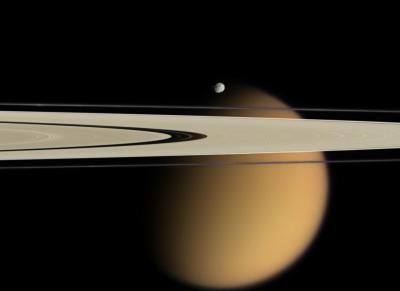Scientists hope that Titan, a moon of Saturn, with its nitrogen-rich atmosphere, could act as a model system for terrestrial chemistry before life began on our planet. Now, another step towards that goal has emerged as researchers at the University of Arizona have incorporated atmospheric nitrogen into organic macromolecules under conditions resembling those on Titan.
“Titan is so interesting because its nitrogen-dominated atmosphere and organic chemistry might give us a clue to the origin of life on our Earth,” explains Hiroshi Imanaka, who is an assistant research scientist in the UA’s Lunar and Planetary Laboratory. “Nitrogen is an essential element of life.” Titan looks orange through a telescope because its atmosphere is a rich smog of organic molecules. Particles in the smog could settle on the surface and be exposed to conditions that might eventually create life, said Imanaka.

Of course, nitrogen alone is not enough, nitrogen molecules must be converted to a chemically active form that can drive the necessary biochemical reactions that underpin biological systems.
Imanaka and Mark Smith converted a nitrogen-methane gas mixture similar to Titan’s atmosphere into a collection of nitrogen-containing organic molecules by irradiating the gas with high-energy ultraviolet light. The laboratory set-up was designed to mimic how solar radiation affects Titan’s atmosphere.
Most of the nitrogen simply formed solid compounds directly, rather than gaseous ones, explains Smith, whereas previous theories suggested that nitrogen would move from gaseous compounds to solid ones in stepwise process. But, those settling particles may not contain nitrogen at all. If some of the particles are the same nitrogen-containing organic molecules created by the UA team in the laboratory then it would suggest that conditions conducive to life might just exist on Titan, Smith says.
These and other laboratory observations help scientists planning future space missions to decide on what to look for on other worlds that might hint at life and what instruments should be developed to help in the search.
Links
Proc Natl Acad Sci, 2010, online
Mark A. Smith homepage
UA lunar and planetary laboratory